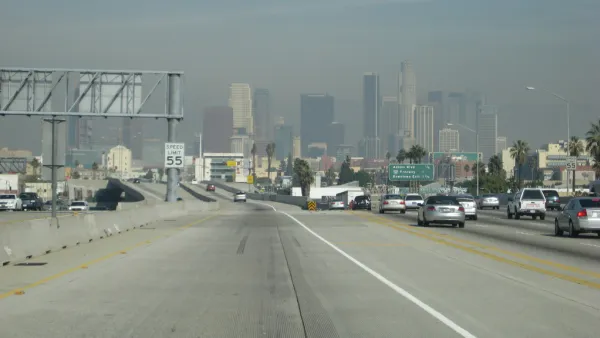Joanna Zelman reports on the good news and bad news contained in the American Lung Association's just released study, "State of the Air 2012." If you live in California, you may not want to read on.
Released Wednesday, the State of the Air report examined 2008-2010 ozone levels, the main ingredient of smog air pollution, and air-particle pollution at official measuring sites across the U.S.
Big picture, there was good news to be had. "Out of the 25 cities with the most ozone pollution, 22 saw improvements in air quality over last year's report. Similar advancements were seen among cities with the most year-round particle pollution," notes Zelman. Unfortunately, the good news didn't go much further. "More than 127 million Americans -- about 41 percent of the country -- still suffer from pollution levels that can make breathing dangerous."
In the rankings of the regions with the most year-round particle pollution, the first five of the top ten are all located in California, with 1) Bakersfield and Delano, 2) Hanford and Corcoran, and 3) Los Angeles, Long Beach, and Riverside, leading the list.
According to Zelman, "California regions face challenges due in part to the agricultural processes, weather and goods-movement industry there. The goods-movement industry includes everything from ships, trucks and trains to machines that load and unload freight and stock store shelves."
FULL STORY: State Of The Air 2012: American Lung Association Reports Improvements, Challenges

National Parks Layoffs Will Cause Communities to Lose Billions
Thousands of essential park workers were laid off this week, just before the busy spring break season.

Retro-silient?: America’s First “Eco-burb,” The Woodlands Turns 50
A master-planned community north of Houston offers lessons on green infrastructure and resilient design, but falls short of its founder’s lofty affordability and walkability goals.

Delivering for America Plan Will Downgrade Mail Service in at Least 49.5 Percent of Zip Codes
Republican and Democrat lawmakers criticize the plan for its disproportionate negative impact on rural communities.

Test News Post 1
This is a summary

Test News Headline 46
Test for the image on the front page.

Balancing Bombs and Butterflies: How the National Guard Protects a Rare Species
The National Guard at Fort Indiantown Gap uses GIS technology and land management strategies to balance military training with conservation efforts, ensuring the survival of the rare eastern regal fritillary butterfly.
Urban Design for Planners 1: Software Tools
This six-course series explores essential urban design concepts using open source software and equips planners with the tools they need to participate fully in the urban design process.
Planning for Universal Design
Learn the tools for implementing Universal Design in planning regulations.
EMC Planning Group, Inc.
Planetizen
Planetizen
Mpact (formerly Rail~Volution)
Great Falls Development Authority, Inc.
HUDs Office of Policy Development and Research
NYU Wagner Graduate School of Public Service





























